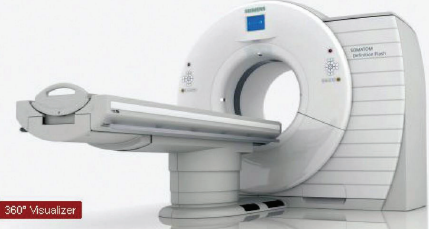Your CT colonography scan
Download and print as a PDF
DownloadWhat is a CT colonography scan?
CT stands for Computerised Tomography. A CT scanner is a ‘doughnut- shaped’ machine that uses x-rays to produce more in depth images of the body. Instead of producing a single picture like an x-ray, the scanner produces many pictures in ‘slices’ through the body.
It can help us find the cause of your problem and help identify the best treatment options for you.
Colonography means that the examination will be focused on your colon (large bowel). During the procedure, gas will be used to inflate your colon via a small flexible tube inserted into your back passage. When there is enough gas in the colon, images will be taken with you lying in two different positions (on your back
and front). If you are unable to lie in either of these positions the radiographers will adapt the technique to ensure the best comfort for you.
You may be given an injection of a muscle relaxant to avoid bowel spasm.
How should I prepare for my CT scan?
Please check your appointment letter for specific information regarding your scan.
You will need to follow a low fibre diet for 2 days before the scan, and be given some laxative tablets (to empty the colon) as well as a special drink which shows up on x-rays. Further information about a low fibre diet and the prep required will be detailed in your appointment letter.
If you have any special circumstances, or requirements regarding the preparation, please let us know.
You may need to spend 30 minutes to 2 hours (though 2 hours is rare) in the department. We will try to keep to your appointment time but occasionally we have to scan patients urgently at short notice. This means that your appointment may be delayed. We will let you know if this is the case when you arrive for your appointment.
What happens during the scan?
You will be asked to undress and put on a hospital gown. Please consider removing jewellery and leaving any valuables at home.
- When you enter the room, the radiographer will explain all the procedure and answer any questions you may have. Then, you will be asked to lie on a narrow, slightly concaved bed.
- The scanner looks like a large doughnut. You will not be enclosed in a tunnel.
- The radiographer will be in the room with you whilst the gas is going into your colon. Whilst scanning, the radiographer will be able to see, speak to and hear you.
- As the scan commences, the scanner will make a whirring noise and the bed will move in and out of the scanner.
- You will be asked to hold your breath for a few seconds as each picture is taken. You should not feel any pain during the scan.
- If you are having an injection of X ray dye, you might have a hot flush and get a metallic taste in your mouth.
- Some patients also experience a sensation like they are wetting themselves; these sensations are normal and pass within moments.

What happens after the scan?
If you have had a contrast injection you will need to stay in the department for at least 15 minutes after your scan to make sure you feel well. You will still be able to drive home.
Once you return home, you will be able to eat and drink as normal for you. Spicy and rich food should be avoided for a couple of days, to ensure no more laxative effects. You may be advised by the radiographer to drink some extra fluid.
The results will be sent to the doctor who asked for you to have this examination.
What are the risks of having a CT scan?
As CT scans involve the use of x-rays, there is a small risk associated with the radiation dose you will receive.
When your referral form is received by the Imaging Department, a team of Radiographers and Radiologists carefully check the request to see if the benefit of having the scan would outweigh the risk of the dose of radiation you will receive.
Although radiographs or ‘x-rays’ have a lower radiation dose associated with them, CT scans provide a more detailed ‘3D’ picture of what is going on inside the body. This can significantly aid your diagnosis or treatment.
If you are required to have an injection for your scan, there is a small risk of having a reaction to the contrast dye. This is a very rare occurrence.
Alternatives to CT
If you are unable to tolerate a CT scan, your referring doctor will be informed and he/she can decide if an alternative examination may be more appropriate for you.
How to find us
Royal Sussex County Hospital (BN2 5BE)
The CT scanner is located on Level 5 of Thomas Kemp Tower Block. Enter through Accident and Emergency entrance and follow signs.
Princess Royal Hospital (RH16 4EX)
The CT scanner is located on the ground floor of the hospital in the Imaging (X-ray) department. Enter through the main entrance of the hospital, continue past the refreshment area and turn left. Go past the lifts and X-ray is at the end of this corridor on the left hand side.
Advice Line for CT enquiries:
01273 523040
Monday to Friday 08.00-16.00
This information is intended for patients receiving care in Brighton & Hove or Haywards Heath.
The information here is for guidance purposes only and is in no way intended to replace professional clinical advice by a qualified practitioner.
Publication Date: August 2021
Review Date: May 2024


